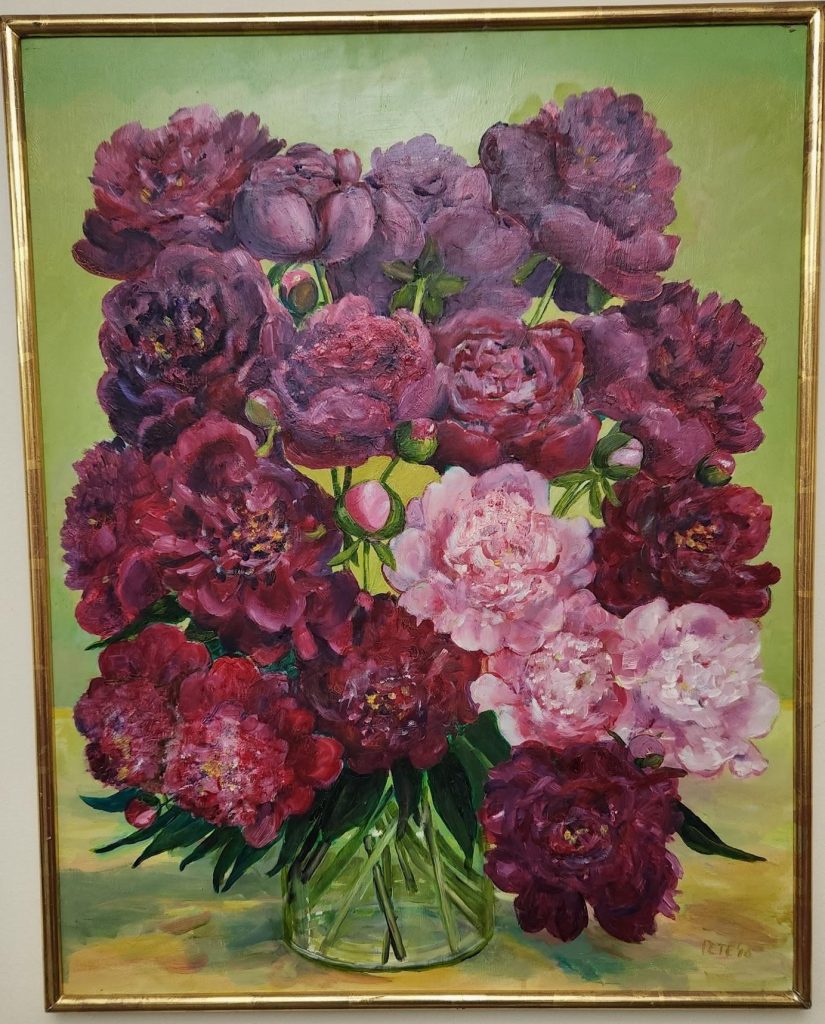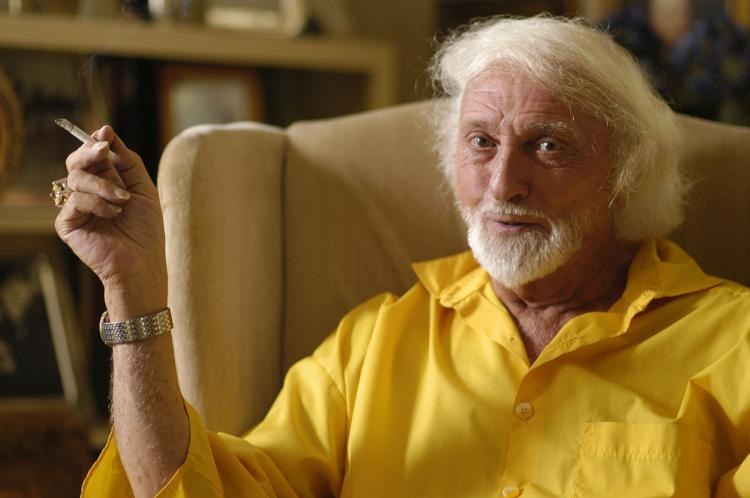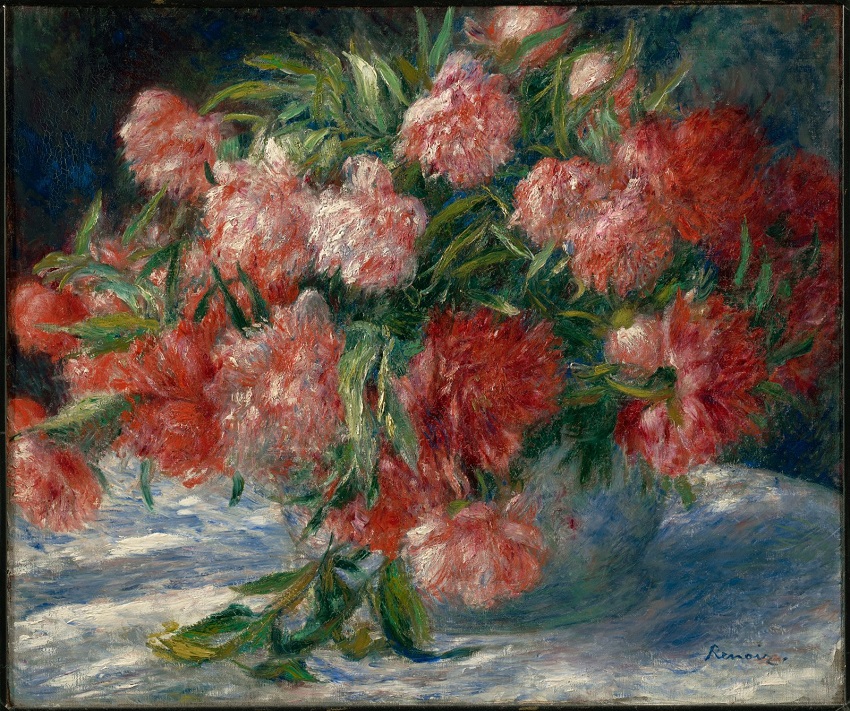Painting Pleasing Peonies
Posted by Admin.September 26th, 2022
Written by Erica Uszak, Graduate Assistant

Peonies were a popular choice of painters, especially for artists of China and Japan and French impressionist artists. French impressionist painter Pierre-Auguste Renoir said that “painting flowers rests my brain. . . . I place my colors and experiment with values boldly, without worrying about spoiling a canvas.”[1] The same held true for West Virginia artist Arthur J. “Pete” Ballard, who said he too “love[d] to play with color, light, shadows, seasons, the sky.”[2] His “James Woods Crimson Peonies” painting exemplifies this obsession with vibrant colors, quick brush strokes, and contrast with lighting.
“For almost sixty years, I have ached to paint peonies,” Ballard wrote in one reflection upon his work.[3] Born in Welch, West Virginia, in 1931, Ballard won an art scholarship to attend a fine arts school, but he decided that he wanted something more. He graduated with a degree in education from Concord University. Much of his post-collegiate life was spent as a teacher, as he taught English in China, India, Saudi Arabia, and other places.

However, he remained fascinated by art and costume design. Upon returning to the United States, he was an instructor at the North Carolina School of the Arts. He further developed his passion for costumes through conservation of old costumes and his design of historical dolls, which exhibited the fashions of the eighteenth to early twentieth centuries. He worked as a curator for fashion exhibits at many North Carolina and other museums. The Ballard collection at the WVRHC includes many papers and articles about his lectures, exhibits, dolls, and paintings. The collection also contains many paintings of flowers, still life and other subjects (to see more about the collection, A&M 3869, see the finding aid). It was not until his retirement when he could pursue painting further, which Ballard was happy to do. “It’s an exciting way to spend one’s time in retirement. You can make all the mistakes you want, then correct them,” and added, “There are endless possibilities for subject matter.”[4]
There are also endless possibilities for painters when it comes to painting peonies. Ballard noted, “The enormous beauty of peonies has always held a fascination for artists.”[5] In Chinese and Japanese culture, peonies are a symbol of status, wealth, and beauty. In China, where these flowers have been grown for several thousand years, they are referred to sometimes as “the king of flowers.” Since Ballard spent time in China, perhaps he was influenced by different styles of Chinese artists and paintings of peonies and other flowers. French impressionist artists also took to painting flowers, especially peonies, as they offered many opportunities for color and light experimentation. Many of Ballard’s favorite artists were impressionists, as he described his admiration for artists like John Singer Sargent and Joaquín Sorolla, both of whom painted in impressionist style.

Ballard’s “James Woods’ Crimson Peonies” painting demonstrates impressionist influences. The colors are vibrant. Although the peonies are described as “crimson,” there is no one color that defines the painting, which awes the viewer with a wide array of pinks, purples, and reds. Ballard catches the light and shadows of the painting, making the peonies seem life-like. The vivid green background suits the painting well. When trying to find another color to use as the background for this painting, Ballard couldn’t help but paint it green. “The hills were green, so were the trees; the grass was green, so were all the leaves,” Ballard wrote, thereby settling on the color of nature as his background.[6]
After so many years, Pete Ballard was finally able to fulfill his aching desire to paint these bright peonies. The “James Woods’ Crimson Peonies” picture exemplifies the complexities of painting such beautiful, colorful flowers that have garnered admiration from painters and viewers alike around the world.
[2] “Memories and Momentos: Artwork by Peterstown Resident on Display in N.C.,” May 11, 2000, Bluefield Daily Telegraph, Box 2, “2000 Exhibition of My Paintings at Gertrude Smith House-Mt. Airy, NC.” Arthur J. Ballard, Costume Artist and Curator, Papers, A&M 3869, West Virginia and Regional History Center, West Virginia University Libraries, Morgantown, West Virginia.
[3] Pete Ballard, “Memories and Mementos: A Collection of Paintings and Commentaries,” 2000, Box 2, “2000 Exhibition of My Paintings at Gertrude Smith House-Mt. Airy, NC.” Arthur J. Ballard, Costume Artist and Curator, Papers, A&M 3869, West Virginia and Regional History Center, West Virginia University Libraries, Morgantown, West Virginia.
[4] “Memories and Momentos: Artwork by Peterstown Resident on Display in N.C.”
[5] Pete Ballard, “Memories and Mementos: A Collection of Paintings and Commentaries,”
[6] Pete Ballard, “Memories and Mementos: A Collection of Paintings and Commentaries.”





